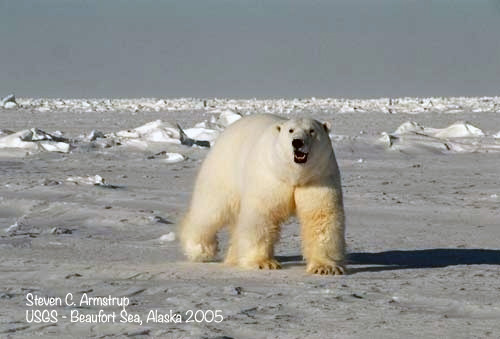
Through the Eyes of a Polar Bear
June 24, 2014
"We deployed two video cameras in 2013, but did not get any footage because the batteries weren’t able to handle the Arctic temperatures,” said Dr. Todd Atwood, research leader for the USGS Polar Bear Research Program. “We used different cameras this year, and we are thrilled to see that the new cameras worked."
Male polar bear approaches biologists. Beaufort Sea, Alaska, 2005
Scientists with the USGS have been studying polar bear movement and habitat use for decades using radio and satellite telemetry, mostly used to determine a polar bear’s location. New video collars allow scientists to link the location data from the collar with the actual behavior recorded by the cameras. Although these collars were only on for about 8-10 days, scientists can start to understand the activity patterns of polar bears, for example how often they eat, hunt, rest, walk, and swim and how these behaviors may be affected by sea ice conditions and other variables. Ultimately, this information will help scientists examine the energetic rates and nutritional demands of these animals and the potential effects of declining sea ice conditions,” said Pagano. This ongoing research is part of the USGS Changing Arctic Ecosystems Initiative. This research is also relevant to the U.S. Fish and Wildlife Service Polar Bear Recovery Team of which the USGS is a member. The team is drafting the Polar Bear Conservation Management Plan, which will meet requirements of both the Endangered Species Act and Marine Mammal Protection Act. The required plan, when finalized, will guide activities for polar bear conservation in response to the 2008 determination that the polar bear is a threatened species due to the ongoing loss of sea ice habitat from global climate-change.
Source of News:
|
||
